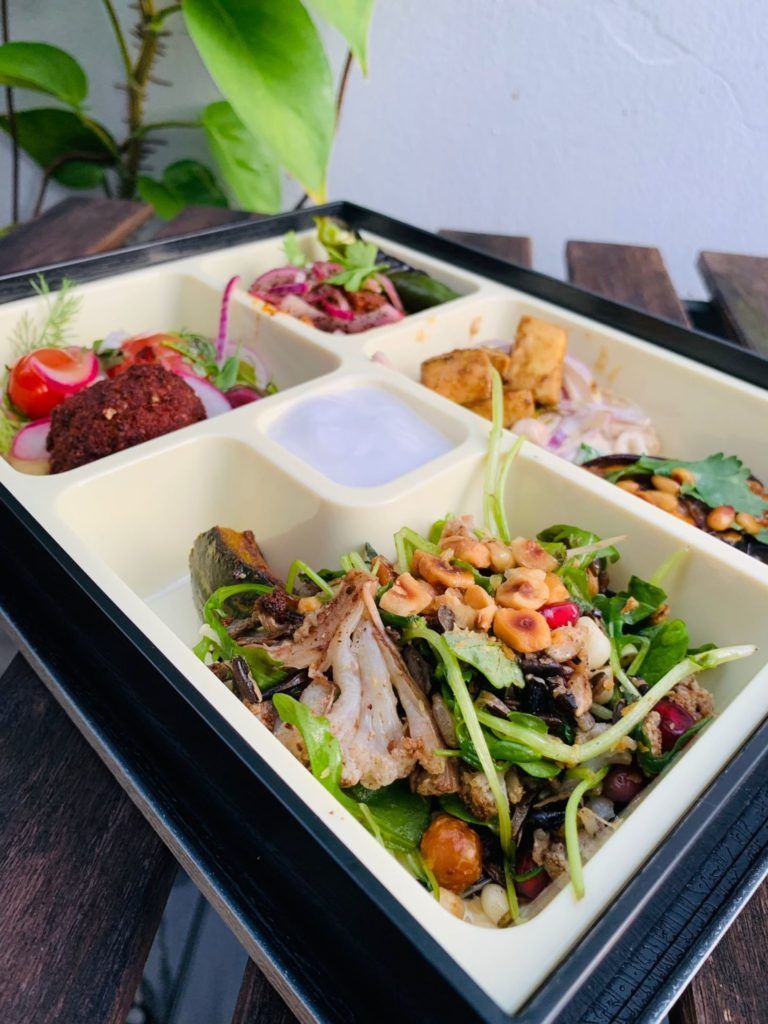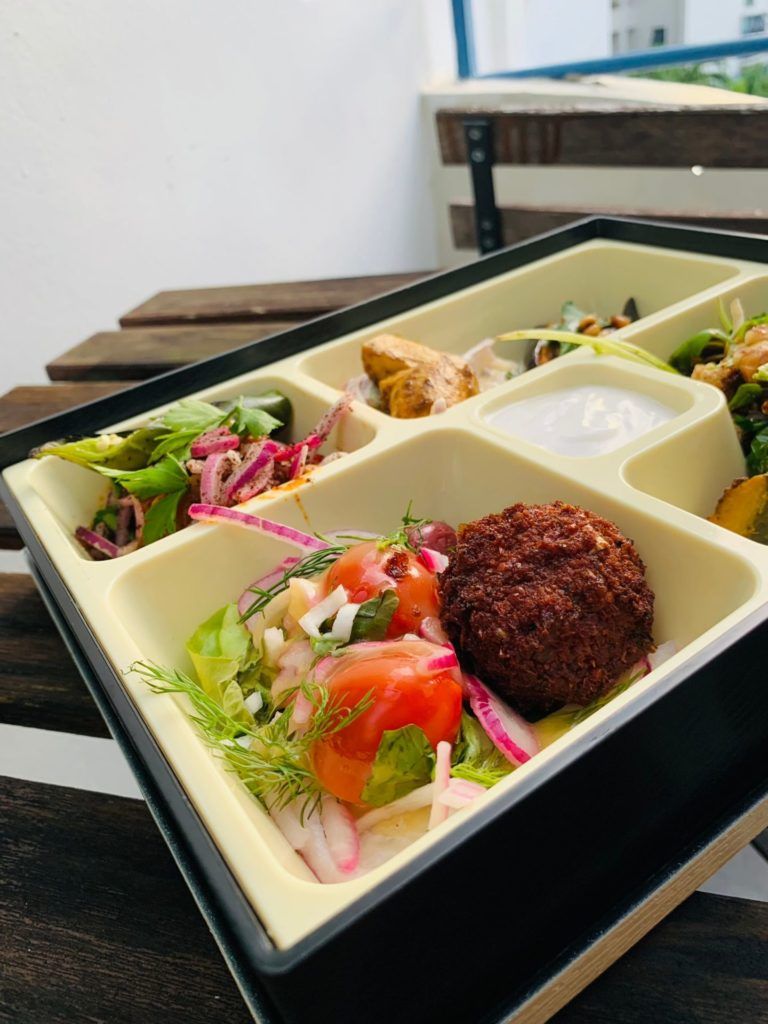Plant-based proteins have certainly made a splash in the foodservice sector for convenience foods like burgers, nuggets, links, and tenders.
At the other end of the scale, a handful of high-profile chefs have made the move to plant-based haute cuisine: for example, Daniel Humm has completely rid the menu at his three Michelin-starred Eleven Madison Park restaurant of animal products, alongside Dominique Crenn of Atelier Crenn.
Some plant-based protein startups have signed up celebrity chefs to their cause; Impossible Foods‘ partnership with Momofuku‘s David Chang is perhaps the best known, as he was the first to serve Impossible Beef to the public – ever! — in 2016. More recently, Singapore’s Next Gen Foods appointed Andrew Zimmern as culinary advisor in March this year.
But there’s plenty of space between fine dining and fast food where enhanced plant-based options could prove popular. One key area is catering: workplace canteens, school cafeterias, hospital cafes, and the like – where millions of people around the world eat at least one meal per workday.
That’s the thesis behind the plant-based menu launched last month by the Singapore branch of Sodexo, one of the world’s largest operators of on-site foodservice facilities, in collaboration with celebrity chef Bjorn Shen.
‘33% plant-based by 2025’
Abel Ariza, president, Malaysia & Singapore, Sodexo told AFN that the company’s customers are increasingly demanding “healthy menu options, including plant-based dishes.”
“The company is committed to [offering] 33% plant-based dishes in its menus by 2025 and [is] actively working with partners to develop new plant-based innovative solutions,” he said.
Singaporean Shen runs Middle Eastern-inspired restaurant Artichoke and is a judge on the city-state’s incarnation of TV’s MasterChef.
“Chef Bjorn is an exceptional and innovative local chef known for putting creative spins on homely food,” Ariza said. “We want to tap on his expertise and creativity to show our consumers that they can spice up simple, everyday ingredients with a healthy and delicious twist, and elevate their everyday experience with meat alternatives.”
The plant-based menu he has designed with Sodexo is, like his flagship restaurant, Middle Eastern-inspired; and it has been served exclusively to the company’s existing consumers in schools and workplaces across Singapore since April.
However, this reporter got a chance to try it out via home delivery. Read on for my review…
The menu:

Arriving at my doorstep in a bento box, the meal essentially comprised five mezze:
- İmam bayıldı: eggplant, smoked tomato, pine nuts
- Hummus msabaha, mushroom shawarma
- Wild rice pilaf: ras el hanout-roasted pumpkin and cauliflower, nuts, seeds, and sprouts
- Beetroot falafel salad: watercress, mango amba, roasted grapes, pickled jicama, dill
- Impossible Beef kofte Iskender: in a tomato and red pepper sauce with a coconut yogurt
According to Ariza, the menu consists of a selection of sustainable plant-based recipes from the Future 50 Food list, which it put together with Knorr and the World Wildlife Fund.
The list “includes often overlooked plant-based ingredients that are nutritious, inexpensive, and have a low carbon footprint such as vegetables, grains, cereals, seeds, legumes, and nuts from across the globe,” he explained, adding that the meals “are intended for dine-in consumption, reducing the need for single-use packaging.”
The verdict:
İmam bayıldı
The Turkish name of this sumptuous Ottoman dish translates as “the imam fainted.” Some say he fainted because of the food’s transcendental deliciousness; others, because of the bill he was handed after finishing (historically, several of the ingredients were considered luxurious and would’ve come with a hefty price tag.)
In any case, this ancient dish was plant-based centuries before plant-based was even a thing. And it has always been one that has been able to go 12 rounds with anything containing animal protein.
Shen’s version here contains the classic whole aubergine stuffed with onion and garlic, and fried in lashings of olive oil. He accentuates the already abundant umami qualities with the addition of smoked tomato, making the imam’s case for dropping meat from his diet altogether all the more stronger.
A hard one not to like.
Hummus msabaha
I had to look up what msabaha was. Turns out it’s quite a bit like the hummus it is paired with here; it’s a more rustic chickpea preparation, with the legumes largely left whole.
In other words: if you’re a fan of hummus, and you don’t have a problem with unmutilated chickpeas, then you’ll probably love this. I certainly did.
The accompanying mushroom ‘shawarma’ doesn’t truly evoke the smoky, fatty layered meat hissing on the spit; it’s more of a salad of marinated and sliced mushrooms. But they do taste good, and are comfortable in their role as an understudy to barbecued lamb (but without the all-important charred, gnarly bits, it must be said.)
Pilaf
If you’re anything like me, any utterance of the phrase ‘wild rice salad’ immediately triggers tears of boredom as you contemplate the prospect of a bland, ligneous, and aimlessly chewy ordeal beloved mainly by those of us who are on a permanent health trip.
Yet — and without wanting to go overboard — this dish was a somewhat revelatory experience for me. As in: not the kind of thing I’m likely to ask for if I were queueing up in a Sodexo-operated canteen, but definitely the kind of thing I’d still enjoy if it was all they had left.
Here, the wild rice was light and nutty — rather than having the textural quality of a spoonful of sodden woodchips — and accentuated with roast hazelnuts. The sprouts added little bursts of crisp, mountain-stream freshness amid the earthiness of the rice kernels. The roasted pumpkin and cauliflower tag-teamed well with the rice to create an overall mouthfeel that successfully mirrored that of a meat dish.
Falafel

Falafel is one of those things which, in my opinion, has to be eaten almost immediately out of the fryer in order to be truly satisfying. Only when it has just passed the point of being able to sear the insides of your mouth is it going to maintain that prized combination of crispy, crunchy outer crust with pillowy, savory, and slightly spicy goodness inside.
These falafel had obviously had a bit of downtime while in transit (I can’t blame the kitchen for that – they had to get it to me somehow) and once they arrived, they’d assumed a slightly tougher texture. Perhaps that won’t be a problem if this is served in a canteen setting, since the journey from fryer to plate will be that much shorter.
Nevertheless, the flavors were superb and — as with all the other items on this plant-based menu — the visual appearance was stunning. The beetroot element, which was not discernible as a discrete part of the dish, instead made its presence known by imparting a vivid ruby color to the falafel ball. The grapes and mango added a welcome sweetness and acidity to cut through the delightful stodge of the falafel.
And perhaps most importantly, it did what all good falafel should do to carnivores: it makes you forget about meat.
Kofte
The coconut yogurt served alongside this dish was, for me, the least enjoyable part of the meal. It wasn’t clear where Sodexo had sourced this from but most coconut-based alt-dairy I’ve tried just doesn’t taste, look, or feel very much like the cow-derived original. This one was a translucent, ghostly white, with a synthetic off-note in its taste that put me more in mind of the skincare products that overpopulate my wife’s dressing table, rather than something you’d want to drizzle over your kebab. But most of all, it tasted incontrovertibly and irredeemably of coconut. I love coconut, but for me, it just doesn’t cohere with the Mediterranean and Middle Eastern flavors on offer here.
But let’s finish on a high note – the kofte Iskender itself.
In a word: Yummy. There was barely any daylight between these Impossible meatballs and the ones conventionally made of beef or lamb. The ‘liverey’ notes that many diners report in Impossible’s beef analogs could still be detected here, even above the strong flavors of the tasty Iskender sauce – but that wasn’t a problem for me. Given that the sauce is as much a star of this dish as the meatballs then all-in-all they were as good as, or better than if they had been made with animal protein.
In conclusion: If this meal represents the school or hospital canteen food of the future, then count me in.
With the exception of the yogurt analog, every single bite proudly stated ‘freshness,’ and did what Eastern Mediterranean and Middle Eastern cuisines do best: taking simple and mostly plant-derived ingredients and somehow getting an extraordinary depth and complexity of flavors out of them.




